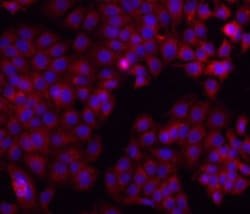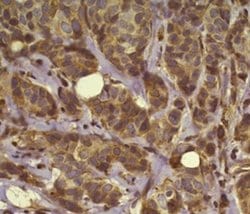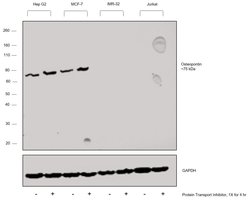Learn More
Osteopontin Monoclonal Antibody (2F10), eBioscience™
Osteopontin Monoclonal Antibody (2F10), eBioscience™
Supplier: LIFE TECHNOLOGIES 14909682

Description
Osteopontin Monoclonal Antibody for Western Blot, ICC/IF, IHC (P)

Specifications
| Osteopontin | |
| Monoclonal | |
| 0.5 mg/mL | |
| PBS with 0.09% sodium azide; pH 7.2 | |
| P10451 | |
| SPP1 | |
| Affinity chromatography | |
| RUO | |
| 6696 | |
| 4°C | |
| Liquid |
| Immunohistochemistry (Paraffin), Western Blot, Immunocytochemistry | |
| 2F10 | |
| Unconjugated | |
| SPP1 | |
| 2AR; 2b7; 44 kDa bone phosphoprotein; Apl-1; BNSP; Bone sialoprotein 1; Bone sialoprotein 1 (BSPI/BSP1); Bsp; BSPI; Calcium oxalate crystal growth inhibitor protein; CALPHA1 fusion; Early T lymphocyte activation 1 (ETA1); early T-lymphocyte activation 1; early T-lymphocyte activation 1 protein; Eta; ETA-1; HGNC:11255; immunoglobulin alpha 1 heavy chain constant region fusion protein; MGC110940; Minopontin; nephropontin; Op; Opn; Opnl; OSP; osteopontin; osteopontin/immunoglobulin alpha 1 heavy chain constant region fusion protein; osteopontin-like protein; PSEC0156; Ric; Secreted phosphoprotein 1; secreted phosphoprotein 1 (osteopontin bone sialoprotein I early T lymphocyte activation 1); secreted phosphoprotein 1 (osteopontin, bone sialoprotein I, early T-lymphocyte activation 1); Secreted phosphoprotein 1 (SPP1); secreted phosphoprotein 1 variant 6; Sialoprotein (osteopontin); SPP1; SPP-1; SPP1/CALPHA1 fusion; unnamed protein product; urinar; urinary stone protein; Uropontin | |
| Mouse | |
| 100 μg | |
| Primary | |
| Human | |
| Antibody | |
| IgG1 κ |
Safety and Handling
The Fisher Scientific Encompass Program offers items which are not part of our distribution portfolio. These products typically do not have pictures or detailed descriptions. However, we are committed to improving your shopping experience. Please use the form below to provide feedback related to the content on this product.


